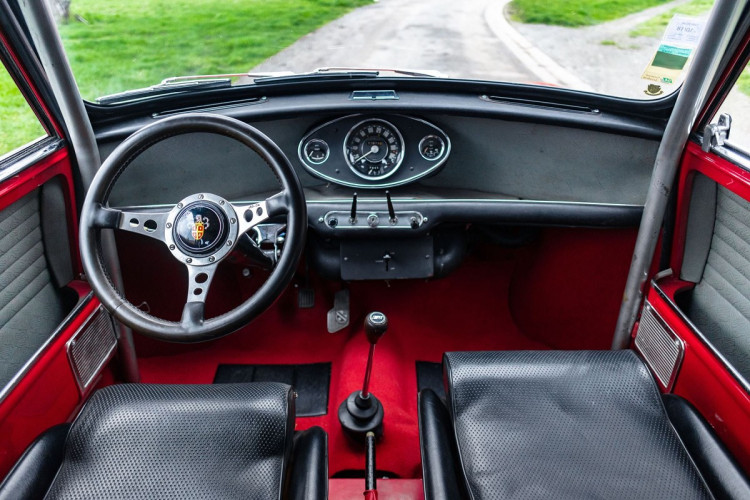In the mid-20th century, an automotive revolution was brewing in the streets of Britain. The compact and charismatic 1967 Austin Mini Cooper emerged as a symbol of innovation, style, and performance, captivating the hearts of drivers and enthusiasts around the world. Designed by Sir Alec Issigonis and initially introduced in 1959, the Mini Cooper’s timeless charm, efficient design, and racing pedigree set it apart as a true British icon. From its humble beginnings to its remarkable achievements on and off the track, this diminutive car made a big impact, becoming not only a transportation solution but also a cultural phenomenon that continues to thrive today.
A Compact Revolution
The 1967 Austin Mini Cooper was born out of a need for efficient urban transportation in post-World War II Britain. Sir Alec Issigonis, a British-Greek engineer, envisioned a car that could accommodate four passengers while utilizing minimal space and fuel. The result was the original Mini, a small and practical vehicle that redefined the concept of compact cars.
The Mini’s unique layout, featuring a transversely mounted engine and front-wheel drive, maximized interior space while minimizing the car’s overall dimensions. This layout not only allowed for a surprisingly spacious cabin but also contributed to the Mini’s exceptional handling characteristics. As a result, the Mini Cooper quickly garnered attention for its nimble agility, making it equally adept at navigating city streets and conquering winding roads.
Enter the Cooper: Racing Pedigree and Performance Focus
The introduction of the Mini Cooper in 1961 marked a turning point for the brand. John Cooper, a renowned race car designer, recognized the Mini’s potential on the track and collaborated with Issigonis to create a performance-oriented variant. The result was the Mini Cooper, named after Cooper’s racing team. This collaboration gave birth to a compact car with a competitive edge, perfectly suited for rallying and circuit racing.
The Cooper’s modifications included a more powerful engine, improved suspension, and performance-focused enhancements. These upgrades transformed the Mini into a formidable competitor in motorsports. Its light weight, front-wheel-drive layout, and precise handling made it a force to be reckoned with on the race track, leading to victories in various rally events, including the prestigious Monte Carlo Rally.
Cultural Icon and Pop Culture Impact
By the time the 1967 Austin Mini Cooper arrived on the scene, the car had already achieved iconic status. Its blend of practicality, style, and performance resonated with a wide range of drivers. The Mini Cooper’s distinctive appearance, characterized by its compact dimensions, rounded shape, and prominent grille, made it instantly recognizable on the road.
The Mini Cooper’s popularity was not limited to the automotive world—it also made a significant impact on pop culture. The car’s appearances in films, television shows, and advertising campaigns further solidified its status as a cultural icon. The 1969 film “The Italian Job” featured Mini Coopers in a memorable heist scene, showcasing the car’s nimble agility and starring alongside Hollywood legends. Additionally, the Mini Cooper’s association with British fashion, music, and youth culture of the 1960s contributed to its image as a symbol of style and trendiness.
Customization and Personalization
One of the Mini Cooper’s unique attributes was its versatility for customization and personalization. Owners could choose from a wide range of colors, patterns, and accessories, allowing them to create a Mini that reflected their individual style. This aspect of the Mini’s appeal further contributed to its widespread popularity, as drivers could make their cars truly their own.
The Mini Cooper’s compact dimensions also made it an ideal canvas for creative modifications. From rally-inspired modifications to aesthetic upgrades, the car’s design lent itself to a variety of aftermarket enhancements. This customization culture not only allowed owners to showcase their creativity but also contributed to the Mini’s enduring allure.
Legacy and Modern Resurgence
Despite its small size, the 1967 Austin Mini Cooper left an outsized legacy that continues to influence the automotive landscape. The Mini’s efficient use of space, front-wheel-drive layout, and emphasis on driving enjoyment laid the foundation for modern compact cars. Manufacturers around the world took inspiration from the Mini’s design philosophy, creating vehicles that prioritize efficiency, urban mobility, and engaging driving dynamics.
The Mini Cooper’s racing heritage also had a lasting impact on the motorsports world. The car’s success in rally events and circuit racing paved the way for future generations of compact performance cars. The lessons learned from the Mini Cooper’s victories contributed to advancements in engineering, suspension tuning, and handling dynamics, shaping the development of sports cars for years to come.
Modern Reinterpretation

In 2001, the Mini Cooper was revived by BMW, capturing the essence of the original while introducing modern technology and safety features. The new Mini Cooper retained the iconic design cues, nimble handling, and customizable options that made the original a sensation. This modern reinterpretation paid homage to the past while embracing the demands of the present, showcasing the enduring appeal of the Mini Cooper’s design and driving experience.
In Conclusion: A Timeless Icon
The 1967 Austin Mini Cooper is more than just a car; it’s a symbol of innovation, style, and performance that transcends time. From its revolutionary compact design to its achievements on the race track and its impact on popular culture, the Mini Cooper’s legacy is felt across generations. Its ability to bring joy to drivers and enthusiasts, its influence on automotive design, and its role as a cultural icon make it a vehicle that will forever occupy a special place in the hearts of those who appreciate its charm, character, and timeless appeal.





